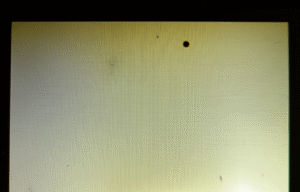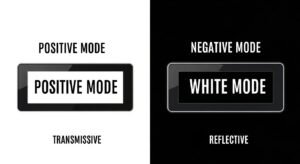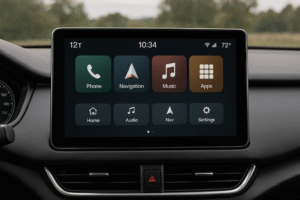
Have you ever designed a product with a display that looked great head-on but became washed out from the side? This common problem can make a high-quality device feel cheap. The solution lies in understanding one key specification: the viewing angle.
Viewing angle in an LCD module is the range of angles from which you can see the screen clearly without the image quality degrading. It defines the cone where the display has acceptable color, brightness, and contrast.
How is Viewing Angle Defined and Measured in LCD Modules?

So, you see these numbers on a datasheet, but what do they really mean? Let’s break down how we define and measure this crucial specification for an industrial lcd.
The viewing angle is officially defined by contrast ratio. It is the angle, measured from the center of the screen, where the contrast ratio drops below a certain level, typically 10:1. This measurement is taken both horizontally and vertically.
The Measurement Process
In our labs, we don’t just eyeball it. We use a specialized instrument called a goniometer. This machine holds the lcd module and rotates it while a sensor measures the brightness and contrast at every single angle.
The Contrast Ratio (CR) Standard: The industry standard for a “viewable” image is a contrast ratio of 10:1. This means the brightness of a fully white pixel is at least ten times greater than a fully black pixel. The angle at which the CR drops below 10:1 becomes the official viewing angle for that direction.
The Viewing Cone: We measure this in four primary directions:
Left (Horizontal)
Right (Horizontal)
Up (Vertical)
Down (Vertical)
These four values (L/R/U/D) combine to form a “viewing cone.” Inside this cone, the image quality meets the minimum standard. Outside of it, you’ll see significant image degradation. This is the core of what does viewing mean in a technical context.
How Do You Read and Interpret LCD Viewing Angle Specifications?
Reading a datasheet can feel like decoding a secret language. The viewing angles are often presented in two ways: by degrees or by a clock-face direction. Let’s make this simple.
A specification like “70/70/50/60” refers to the Left/Right/Up/Down angles in degrees. A “6 o’clock” viewing direction means the best viewing is from below the screen, ideal for devices mounted high up.
Understanding Degree-Based Specifications
This is the most precise method. The numbers are always presented in a consistent order, though the exact order can vary by manufacturer. A common format is:
- L/R/U/D (Left/Right/Up/Down): A spec of
70°/70°/50°/60°means you can move 70° to the left, 70° to the right, 50° up, and 60° down from the center before the contrast ratio falls below 10:1.
Understanding Clock-Based Specifications
This is a more practical, application-focused way to describe the optimal viewing direction, also known as the bias angle. Imagine the display is the center of a clock.
| Clock Direction | Optimal View From… | Common Use Case | What Happens from Opposite Direction? |
|---|---|---|---|
| 12 o’clock | Above (top-down angle) | Automotive dashboards, desktop instruments, rack-mounts | Gray-Scale Inversion from 6:00 |
| 6 o’clock | Below | Wall-mounted controllers, meters, handheld devices | Gray-Scale Inversion from 12:00 |
| 3 o’clock | Left | Less common, for specific portrait-mode applications | Gray-Scale Inversion from 9:00 |
| 9 o’clock | Right | Less common, for specific portrait-mode applications | Gray-Scale Inversion from 3:00 |
Inversion is a critical concept. It’s what happens when you view a display from the direction opposite its bias angle. The colors and shades of gray get inverted, making the image look like a photo negative. This is the most common reason for perceived poor quality in TN-type displays.
Why Does Viewing Angle Matter for LCD Modules?
A narrow viewing angle can ruin an otherwise perfect product. This single specification is often the difference between a happy user and a frustrated one.
It matters because users rarely view screens perfectly head-on. A wide monitor viewing angle ensures consistent image quality for multiple viewers or for devices mounted at fixed, off-center angles, like in a vehicle or on a factory floor.
Applications
- Multi-Viewer Scenarios: Consider a medical device in a hospital room. Multiple doctors and nurses need to see the patient’s vitals clearly from different positions around the bed. A wide viewing angle monitor is not just a feature; it’s a requirement for patient safety.
- Fixed-Mount Equipment: An industrial control panel on a large machine is often mounted at waist or chest height. The operator might be standing, sitting, or moving around. They need to be able to read the display from above, below, and the side without having to crouch down or move into a perfect viewing spot.
- Consumer Electronics: For a personal device like a digital camera, the
viewing anglemight seem less critical. But what about when the user wants to show a photo to a group of friends? A wide viewing angle allows everyone to share the experience without crowding around.
What Factors Affect the Viewing Angle of an LCD?
Not all LCDs are created equal. The technology inside the panel is the biggest factor determining its view angle monitor performance.
The most significant factor is the LCD panel technology. IPS (In-Plane Switching) panels offer the widest viewing angles. TN (Twisted Nematic) panels are faster and cheaper but have much narrower, more limited angles(How Do TN, IPS, and VA LCD Panels Affect Backlighting System Design?).
A Comparison of Panel Technologies

When I work with clients, the conversation almost always comes down to choosing between these three main types of lcd module.
| Technology | Viewing Angle | Response Time | Contrast Ratio | Cost | Best For… |
|---|---|---|---|---|---|
| TN (Twisted Nematic) | Poor | Fastest | Good | Lowest | Gaming monitors, cost-sensitive projects |
| VA (Vertical Alignment) | Good | Medium | Best | Medium | TVs, applications needing deep blacks |
| IPS (In-Plane Switching) | Best | Slowest | Good | Highest | Medical, industrial, professional graphics |
TN (Twisted Nematic): This is the oldest and most common technology. The liquid crystal molecules twist like a staircase. It’s fast and inexpensive, but this structure causes significant color and contrast shifts when viewed off-center. This is where you see the most dramatic gray-scale inversion.
VA (Vertical Alignment): Here, the molecules are aligned vertically and tilt when a voltage is applied. This allows for very deep blacks and high contrast ratios but can sometimes lose detail in shadows when viewed from the side.
IPS (In-Plane Switching): This is the gold standard for viewing angles. The liquid crystal molecules are aligned horizontally and rotate in parallel to the screen. This structure keeps colors consistent even at extreme angles. When someone asks for an ips display difinition, I tell them it’s a technology built for color accuracy and wide viewing angle angles. The ips panel viewing angle is consistently superior.
How Do I Select an LCD Module with the Correct Viewing Angle for My Application?
Choosing the right LCD doesn’t have to be complex. It starts with asking a few simple questions about how your product will be used.
First, clearly define your product’s use case. Who is the user, and from what angles will they see the screen? Then, match this need to the datasheet, selecting a clock direction or degree range that fits.
A Practical Checklist
When I consult with a client, I walk them through these questions to narrow down the options:
Where will the product be mounted?
Above the user’s eye level? -> You need a 6 o’clock display.
Below the user’s eye level? -> You need a 12 o’clock display.
At eye level? -> A standard display is fine, but consider the left/right angles.
Will multiple people view it at once?
Yes? -> You absolutely need a wide viewing angle technology like IPS. A standard TN panel will not work.
No, it’s a single-user device? -> A TN panel with the correct viewing direction (6 or 12 o’clock) is a cost-effective choice.
Will the display be in portrait or landscape orientation?
Landscape? -> Most standard displays are optimized for this.
Portrait? -> This is a special case. You need to be very careful. (More on this next).
What is your budget?
Cost-sensitive? -> TN is your best bet, but you must get the viewing direction right.
Performance is key? -> Invest in an IPS display. The superior ips display viewing angle is worth the extra cost for many applications.
Considerations for Using LCD Modules in Vertical Orientation
This is a common trap I see engineers fall into. You can’t just take a standard landscape display and turn it on its side without consequences.
When you rotate a standard landscape LCD 90 degrees, the horizontal and vertical viewing angles swap. A wide horizontal view becomes a narrow vertical view, which is often terrible for a portrait-mode device.
The Orientation Problem
Here’s the issue: a standard TN display might have a horizontal viewing angle of 90° (±45°) but a vertical top-down angle of only 50° (e.g., +20°/-30°).
In Landscape: This is fine. You have a wide side-to-side view.
Rotated to Portrait: Now your side-to-side view is only 50°, and your up-and-down view is 90°. This means the person using the device has to hold it at a very specific height to see it clearly, while someone looking over their shoulder might see a great image. It’s the opposite of what you want.
The solution? If you use the wide LCDs build it vertically. Specifically, use an IPS panel. Because an ips monitor viewing angle is wide in all directions, it looks great in both landscape and portrait mode. Alternatively, you can source a module specifically designed for portrait use.
What Does a "178°/178°" Viewing Angle Specification Really Mean?
You see this “178°/178°” number in marketing materials for high-end monitors. It sounds like perfection, but what does it mean in the real world?
A 178°/178° viewing angle is a marketing term that indicates an IPS or similar wide-viewing-angle technology. It means the contrast should remain above 10:1 almost to the edge of the screen, providing excellent color consistency.
Beyond the Marketing Hype
That 178° number is the result of the measurement standard. It essentially means the display is viewable from almost any angle. This is the key benefit of the ips viewing angle.
However, it’s not the whole story. Even on the best IPS panels, you might notice some subtle changes at extreme angles:
“IPS Glow”: This is a faint glow that can appear in the corners of the screen when viewing dark images from a sharp angle. It’s a characteristic of the technology and is very different from the backlight bleed you might see on cheaper panels.
Minor Brightness Drop: While colors remain consistent, the overall brightness may dim slightly as you move further to the side.
So, while 178° isn’t a magical number guaranteeing perfection, it is a reliable indicator that you are getting a premium panel that will not suffer from the distracting color shifting and inversion issues common to TN displays.
Conclusion
Understanding viewing angle is key to choosing the right LCD. It ensures your product is usable, looks professional, and provides a great user experience from every viewpoint.
FAQ
What happens if I view an LCD from the wrong direction?
The image will look distorted, colors will shift, and it might even appear negative. This phenomenon is called gray-scale inversion and is most common on TN-type displays when viewed from the opposite of their optimal direction.
Is a wider viewing angle always better?
Not always. For single-user devices where privacy is a concern, like an ATM or a medical records station, a narrow viewing angle can be a deliberate feature to prevent others from seeing the screen.
Can I improve the viewing angle of an existing TN LCD?
You cannot change the panel’s inherent properties, but applying a special optical film, known as a wide-viewing-angle film, can help diffuse the light and modestly improve the viewing cone.
What is the difference between viewing angle and viewing direction?
Viewing angle is the total range you can view the screen from (e.g., 70 degrees left/right). Viewing direction is the single optimal direction for the best image quality (e.g., 6 o’clock or 12 o’clock).
Should I worry about vertical orientation for LCD modules?
Yes, because many modules are optimized for landscape and may have poor vertical viewing; always check specs and test before using vertically.







